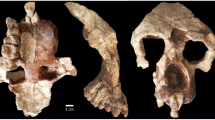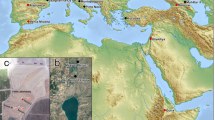Abstract
There are two principal hypotheses about the time of the emergence of the Hominidae, the family that includes man: first, the hominid lineage emerged before 16 Myr ago1–4; or second, living apes and man are so similar genetically that they must have diverged later5, perhaps as late as 5 Myr ago6,7. The first hypothesis is supported primarily by fossil evidence, whereas the second is championed by advocates of the molecular clock6,7. Hominid fossils are abundant back to 3.7 Myr (Australopithecus afarenesis)8 but are rare before that. Ramapithecus (16–8 Myr) was once classified as a member of Hominidae, but recent discoveries and interpretations show that it should be placed in its own family, Ramapithecidae9,10. Two fossil specimens classified as members of Hominidae predate A. afarensis, however: a lower molar from Lukeino in central Kenya dating to 6.5 Myr (KNM-LN 335)11 and a mandibular fragment from Lothagam Hill in north Kenya dated at 5–5.5 Myr (KNM-LT 329)12. Does their morphology justify classification as the first members of Hominidae? Their geological age is relatively secure. The Lukeino Formation which is up to 130m thick is bracketed by K/A dates of 7–5.4 Myr11. The deposits from which the Lothagam Hill mandible derives are disconformably overlain by an intrusive basalt sill with a K/A date of 3.7 Myr and are associated with mammalian fauna that yields a biostratigraphical age of 5–5.5 Myr12,13. We report here a morphological study which indicates that the Lukeino molar has cusp proportions similar to the modern chimpanzee and the Lothagam Hill mandible is morphologically intermediate between modern pongids and A. afarensis.
This is a preview of subscription content, access via your institution
Access options
Subscribe to this journal
Receive 51 print issues and online access
$199.00 per year
only $3.90 per issue
Buy this article
- Purchase on Springer Link
- Instant access to full article PDF
Prices may be subject to local taxes which are calculated during checkout
Similar content being viewed by others
References
Simons, E. L. Primate Evolution (Macmillan, New York, 1972).
Simons, E. L. J. Hum. Evolut. 5, 511–528 (1976).
Simons, E. L. Scient. Am. 236(5), 28–35 (1977).
Pilbeam, D. The Ascent of Man (Macmillan, New York, 1972).
Washburn, S. L. & Moore, R. Ape into Man (Little & Brown, Boston, 1974).
Sarich, V. M. & Wilson, A. C. Science 158, 1200–1203 (1967).
Sarich, V. M. & Cronin, J. E. in Molecular Anthropology (eds Goodman, M. & Tashian, R. E.) (Plenum, New York, 1977):
Johanson, D. C. & White, T. D. Science 202, 321–330 (1979).
Pilbeam, D. A. Rev. Anthropol. 8, 333–352 (1979).
Pilbeam, D. et al. Nature 270, 689–695 (1977).
Pickford, M. Nature 256, 279 (1975).
Patterson, B., Behrensmeyer, A. K. & Sill, W. D. Nature 226, 918–921 (1970).
Behrensmeyer, A. K. in Earliest Man and Environments in the Lake Rudolf Basin (eds Coppens, Y. et al.) (Univ. Chicago, 1976).
Corruccini, R. S. thesis, Univ. California (1975).
Corruccini, R. S. Z. Morph. Anthrop. 68, 14–25 (1977).
Corruccini, R. S. J. dent. Res. 56, 190 (1977).
Corruccini, R. S. J. dent. Res. 56, 1093–1096 (1977).
Corruccini, R. S. Archs oral Biol. 23, 491–494 (1978).
Penrose, L. S. Ann. Eugen. 18, 337–343 (1954).
Blackith, R. E. & Reyment, R. A. Multivariate Morphometrics (Academic, London, 1971).
Corruccini, R. S. Homo 28, 222–226 (1978).
Author information
Authors and Affiliations
Rights and permissions
About this article
Cite this article
McHenry, H., Corruccini, R. Late Tertiary hominoids and human origins. Nature 285, 397–398 (1980). https://doi.org/10.1038/285397a0
Received:
Accepted:
Issue Date:
DOI: https://doi.org/10.1038/285397a0
Comments
By submitting a comment you agree to abide by our Terms and Community Guidelines. If you find something abusive or that does not comply with our terms or guidelines please flag it as inappropriate.



